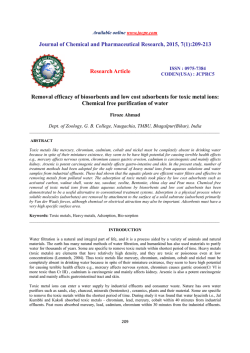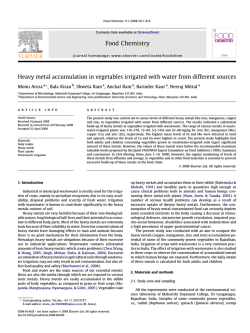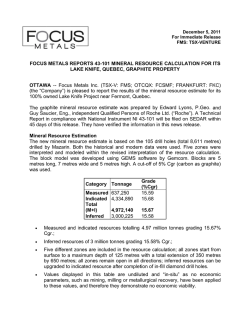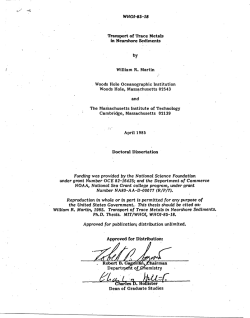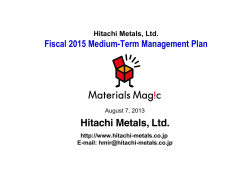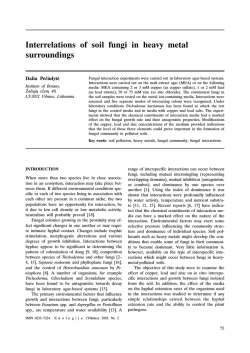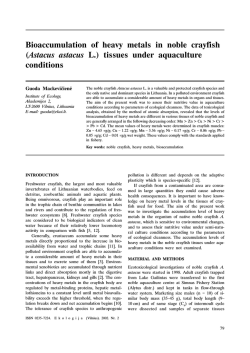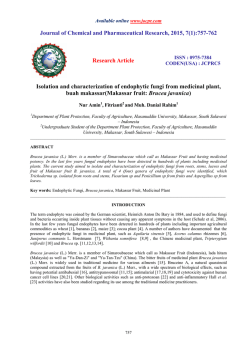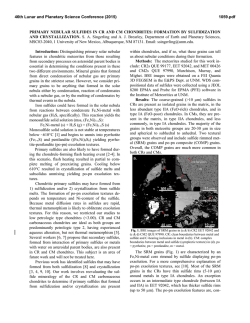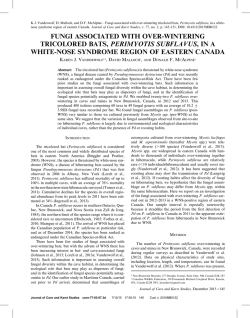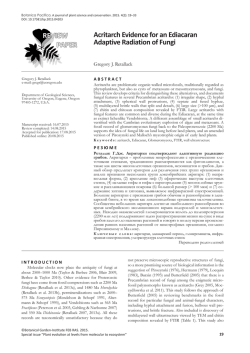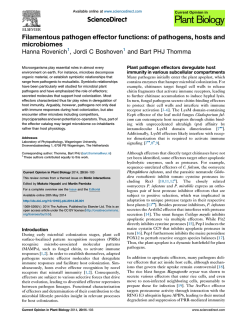
Simultaneous effect of nickel, cadmium and chromium(VI) on soil
Simultaneous effect of nickel, cadmium and chromium(VI) on soil micromycetes Simultaneous effect of nickel, cadmium and chromium(VI) on soil micromycetes L. Levinskaitë Institute of Botany, Þaliøjø eþerø 49, LT-2021 Vilnius, Lithuania Response of soil fungi Alternaria alternata, Penicillium decumbens and Trichoderma viride to cadmium, nickel and chromium(VI) as well as their mixture was studied. Fungal capacity to remove metals from their mixture added into the growth medium was investigated, too. T. viride was the fungus most tolerant towards all test metals and their mixture. This micromycete also removed the highest amounts of the metals. Key words: micromycetes, heavy metals, metal response, metal mixture, metal sorption INTRODUCTION Pollution of soils by heavy metals affects the functioning of microorganisms and induces alterations in their population structure. Filamentous fungi were reported to exhibit considerable tolerance towards heavy metals and become dominant organisms in some polluted habitats [12]. Fungi are also known to accumulate high amounts of metals [34]. This property is of great importance to organisms growing in polluted habitats and for a possible binding of heavy metals in natural environments as well as for their removal from waste waters and other aqueous substrata [56]. Microorganisms in natural ecosystems often encounter not one but several heavy metals. Therefore, fungal tolerance towards a mixture of metals is of high importance both for fungal survival and their application for industrial purposes. The aim of the present study was to assess the effect of a metal mixture versus single metals on the development of soil fungi and to evaluate fungal ability to remove metals from the mixture by growing fungal biomass. MATERIALS AND METHODS Micromycetes were isolated from rhizosphere zone soil under leaf-litter (Verkiai regional park). Three fungi were chosen for investigation: These were Penicillium decumbens Thom 102ML, a frequently encountered soil fungus; Alternaria alternata (Fries) Keissler 41L, able to cause plant diseases, and Trichoderma viride Persoon 11S, the fungus known as a bioagent against pathogens. Fungal sensitivity to- wards heavy metals and their mixture was tested on Czapek medium agar, pH 5.5 [7]. The medium was amended with Cd2+, Ni2+ and Cr6+ at a rate of 0.1 3 mM. The metals were used as salts: CdCl2, NiCl2⋅6H2O and K2Cr2O7. All glassware used for metal studies was washed with 4% nitric acid and rinsed three times with distilled water. Cultures were grown on a solid medium at 25 ± 2 °C and inspected after 7 days. The effect of heavy metals on the growth of fungi was evaluated as changes in the radial hyphal extension rate by measuring the diameter of fungal colonies. All experiments were conducted in triplicates. For metal sorption experiments, fungi were grown in a liquid medium of the same composition with addition of a metal mixture at a concentration of 0.1 mM for each metal. The cultures were incubated on a rotary shaker for 5 days. Biomass amount was evaluated as dry weight obtained by drying at 105 °C for 8 hours. Measurements of metal residues in the growth medium after cultivation were conducted with a Perkin-Elmer Zeeman 3030 atomic absorption spectrophotometer in the Institute of Physics. RESULTS AND DISCUSSION First, the effect of a separate metal on fungi was studied. Fungal response to NiCl2 revealed that the most sensitive fungus was Alternaria alternata 41L whose growth was reduced even by 0.15 mM nickel and absolutely inhibited at 1 mM nickel (Fig.). Most resistant to nickel was Trichoderma viride 11S. Development of Penicillium decumbens 102ML was in- ISSN 13920146. B i o l o g i j a . 2001. Nr. 4 ! L. Levinskaitë tion of 1 mM inhibited the growth of T. viride 11S, whereas the fungus developed on a medium with separate metals at this and higher concentrations. A more negative influence of the mixture was noted on A. alternata 41L. As the results show, T. viride 11S exhibited the highest resistance to all metals and their mixture, P. decumbens 102ML was quite resistant to nickel and sensitive to chromate, and A. alternata 41L was sensitive to nickel and more resistant to chromate. The variance of fungal response could be determined by their individual biology (all micromycetes were from different taxonomic groups), their different metabolites which can bind metals, and their ability to prevent cellular entry of a toxic metal or to compartmentize and detoxify it within the cell [5, 89]. A study of metal accumulation Alternaria alternata 41L showed that the sorption of meTrichoderma viride 11S tals from the medium by different Penicillium decumbens 102ML fungi was not the same. The residual cadmium content in the culFig. Growth response of fungi after 7 days towards nickel, cadmium and chrotural liquid was the lowest when mium (VI) and their mixture. The metals were added as salts: CdCl2, calculated as a percentage 5.6 NiCl2·6H2O and K2Cr2O7 17% (Table). The range of chrofluenced more negatively than that of T. viride 11S, mium amount found in the supernatant after fungal but less than of A. alternata 41L. cultivation was from 18.1 to 32.2%, and the nickel In response to CdCl2, P. decumbens 102ML was content varied within 41.870.6%. There are reports more sensitive as compared to its reaction towards that fungi can bind metals on the cell surface and nickel, and 2 mM cadmium for this fungus was let- uptake inside. High contents of chitin, chitosan and hal. A. alternata 41L growth was also fairly weak, glycans in the cell wall can sorb considerable but it was able to grow slightly when exposed to 3 amounts of metals [910]. Metal uptake inside the mM cadmium. Meanwhile, T. viride 11S exhibited a cell is determined by various and inside and outside considerably higher resistance to cadmium than did factors [9, 11]. the other fungi. Its radial growth was reduced by a T. viride 11S accumulated the highest amount of 3 mM concentration insignificantly and was equal to all metals. A particularly high sorption by this fun75% of its growth on a metal-free medium. gus was observed for cadmium (625 µg/l or 5.6% of The effect of K2Cr2O7 on the radial growth of A. the residual metal). A. alternata 41L accumulated alternata 41L and T. viride 11S almost did not dif- high amounts of cadmium (remained 13.1%). P. defer. A sharp decrease was noticed at a metal con- cumbens 104ML also sorbed cadmium well (left centration of 12 mM and no growth was observed 17.0%), nevertheless, chromium sorption was also at 3 mM. P. decumbens 102ML was more sensitive high. An increase in the uptake of chromium by than the other two fungi to K2Cr2O7. microorganisms can result from reduction of Cr6+ When fungi were cultivated on a medium amen- to Cr3+, which is more amenable to complexation ded with a metal mixture, they responded much mo- [1213]. Metal sorption occurred in the medium rich re sensitively to a mixture of metals than to sepa- in various components, including fungal metabolites, rate ones. P. decumbens 102ML was more tolerant and with an altering medium pH during fungal than A. alternata 41L and more sensitive than T. growth. These reasons could also influence the funviride 11S. The metal mixture even at a concentra- gal ability to sorb metals. " Simultaneous effect of nickel, cadmium and chromium(VI) on soil micromycetes Table. Removal of metals from growth medium by fungi Fungus Alternaria alternata 41L Penicillium decumbens 102ML Trichoderma koningii 11S Metals that remained in the cultural liquid Biomass amount, (dry weight), g µg/l %* µg/l % µg/l % 0.98 ± 0.12 1473 ± 196 13.1 1673 ± 301 32.2 3320 ± 426 56.4 1.24 ± 0.26 1910± 384 17.0 1157 ± 253 22.2 4159 ± 358 70.6 0.87 ± 0.15 625 ± 109 5.6 940 ± 124 18.1 2460 ± 395 41.8 cadmium chromium nickel * The percentage was calculated considering added metal concentration as 100%. No clear correlation between metal accumulation and fungal sensitivity was observed. Some works showed that more sensitive microorganisms sorbed higher amounts of metals as they did not possess the mechanisms determining the efflux of toxic metals from the cell [9, 14]. On the other hand, the resistant organism can translocate heavy metals into intracellular structures up to particular amounts by binding and thereby detoxifying them [5]. In our experiment, 0.1 mM concentration of the metal mixture was considerably less toxic to T. viride 11S than to the other fungi, and T. viride 11S sorbed the highest amounts of all metals. A. alternata 41L and P. decumbens 104ML differed in significantly in their sensitivity to a metal mixture and more to separate metals. No correlation was observed between the accumulation of metals by the latter two fungi and their sensitivity. The results have shown that fungi can withstand rather high concentrations of heavy metals and are able to sorb them from metal mixture in surroundings or aqueous systems rich in organic and inorganic components. Trichoderma viride 11S, which usually is a desirable fungus in many cultural soils as a bioagent against pathogens, manifested a high metal resistance and a high sorption capacity. References 1. Martino E, Turnau K, Girlanda M, Bonfante P, Perroto S. Mycol Res 2000; 104: 33844. 2. Weissenhorn I, Leyval C, Berthelin J Plant and Soil 1993; 157: 24756. 3. Stokes PM, Lindsay JE. Mycologia 1976; 71: 796806. 4. Morley RF, Gadd GM. Mycol Res 1995; 99 (12): 142932. 5. Gadd GM. Fungal responses towards heavy metals. In: Microbes in Extreme Environments. Ed. Herbert RA, Codd GA. London; 1989: 1938. 6. Strandberg GW, Shumate SE, Parrott JR. Appl Environ Microbiol 1981; 41: 23145. 7. Pitt JI. The Genus Penicillium and Its Teleomorphic States Eupenicillium and Talaromyces. London. 1979: 534. 8. Shiegel SM, Galun M, Shiegel BJ. Water, Air and Soil Pollution 1990; 53; 33544. 9. Gadd GM. New Phytologist 1993; 124: 2560. 10. Mohan PM, Sastry KS. Biochem J 1983; 212: 20510. 11. Kong S., Yonge DR, Johnstone DD, Petersen JN. Biotechnol Lett 1992; 14: 5214. 12. Wang YT, Shen H. J Industr Microbiol 1995; 14: 15963. 13. Joho M, Ishikawa Y, Kunuikane M, Inouhe M, Tohoyama H. Microbios 1992; 71: 14959. 14. Mowl JL, Gadd GM. J Gen Microbiol 1984; 130: 27984. L. Levinskaitë BENDRAS NIKELIO, KADMIO IR CHROMO(VI) POVEIKIS DIRVOÞEMIO MIKROMICETAMS Santrauka Atlikti dirvoþemio mikromicetø Alternaria alternata, Penicillium decumbens ir Trichoderma viride reakcijos á kadmio, nikelio ir chromo (VI) bei jø miðinio poveiká tyrimai. Taip pat tirtas grybø gebëjimas sorbuoti metalus ið jø miðinio, ádëto á grybø augimo terpæ. Didþiausiu tolerantiðkumu visø metalø atþvilgiu pasiþymëjo T. viride. Ðis mikromicetas taip pat akumuliavo didþiausius metalø kiekius. #
© Copyright 2025
